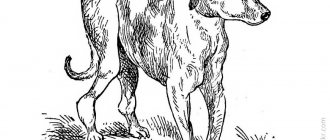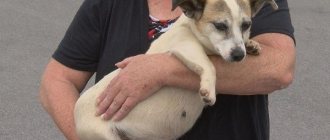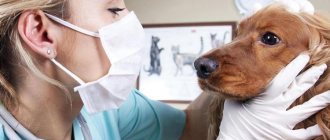How should a healthy dog breathe?
Let's figure out how a healthy dog should breathe. The breathing rate depends on the size of the dog; the larger the size, the fewer breaths it takes per minute. The respiratory rate is measured by recording the movements (raising) of the ribs.
For large dogs, 12-18 lifts per minute is considered normal. Small dogs breathe more quickly, approximately 18–24 breaths per minute. Both the frequency and depth of inspiration are recorded. If, when a dog inhales, the peritoneum, and not the chest, enlarges, this is a symptom of a dysfunction of the respiratory system. In addition, the respiratory rate is measured in conjunction with the pulse.
conclusions
Treatments for shortness of breath will depend on the diagnosis. A special oxygen mask is often used as first aid. In situations where the animal begins to choke, tracheal intubation is performed.
If, under normal conditions, the dog has rapid breathing, and other symptoms of the disease appear, owners should not use the drugs without permission. It is necessary to show it to a veterinarian who will determine the cause and prescribe treatment. The sooner help is provided, the less threat to the dog’s life.
To keep a pet healthy, owners should not forget to create optimal conditions for keeping it.
The main causes of rapid breathing in dogs
The main causes of rapid breathing in dogs can be associated with both internal and external factors. Internal, physiological factors include:
- Any ailments that affect body temperature and metabolism.
- Stress and emotions.
External factors include:
- Air temperature and humidity.
- Atmosphere pressure.
- The situation.
The factors that can cause breathing problems are very extensive, so they need to be considered in more detail.
Why does a dog breathe with its tongue hanging out in the heat: from the point of view of physics
When a dog breathes in the heat with its tongue hanging out, it increases heat transfer by evaporating moisture from the mucous membranes, giving off body heat to the environment. Thermoregulation of the body is carried out due to:
Heat products:
- Decreased physical activity and muscle heat production.
- Slowing down metabolic processes in the body.
- Reducing the body's energy needs.
Heat dissipation:
- Evaporation of fluid from the mucous membrane.
- Evaporation of moisture from the surface of the lungs.
- Transfer of temperature from a heated body to cold air.
Additional symptoms of rapid breathing in dogs and their explanation
You can assume that your dog is sick or suffering from stress only if you know the additional symptoms of rapid breathing in dogs and their explanation. If you realize that something is wrong with your dog, but cannot identify additional symptoms, it is best to consult a veterinarian.
The dog breathes frequently with its mouth open
If your dog is breathing frequently with his mouth open, this may be a sign of:
- Choking.
- Fevers.
- Feeling hot.
When a dog suffocates, the mucous membranes turn pale. Fever is determined by measuring body temperature. When a dog is hot, it breathes with its mouth open to cool itself.
The dog often breathes with its mouth closed through its nose
When a dog frequently breathes with its mouth closed through its nose, the reason for the strange behavior may be:
- Stress.
- Pain syndrome.
- Fatigue.
When a dog is stressed, its heart rate and breathing rate increase. The dog may worry for its own reasons or react to the external situation. Intense breathing through the nose may indicate slight hypoxia, which occurs due to overwork. Overfatigue can occur both after heavy physical exertion and when it is impossible to thrust deeply.
While in pain, which the pet may be enduring, the dog may not show any signs other than heavy breathing. It is important to understand that the source of pain can be anywhere; it can be found by palpation and close observation of the pet.
The dog is shaking and trembling
If your dog is panting, shaking and trembling, the reasons may be:
- Fright.
- Heatstroke or increased body temperature.
- Strong pain.
- Neurological disorders.
The dog may tremble when experiencing strong emotions. Most often, trembling occurs due to fear. Heatstroke and fever cause the blood to thicken. Tremor in this case is a natural reaction of the body associated with an attempt to push clotted blood through narrowed vessels.
With unbearable pain, in addition to tremors and rapid breathing, you can observe apathy and even aggression in the dog. The most difficult thing to diagnose is tremor due to a neurological disorder. Trembling can be a sign of either an indolent neurological disease or a seizure.
A dog breathes with its tongue hanging out in the not hot season
If a dog breathes with its tongue hanging out during a non-hot season, there may be several reasons:
- Increased body temperature.
- Strong emotions or stress.
- Violation of water-salt metabolism.
The amount of saliva secreted directly depends on the water-salt and electrolyte-water balances in the body. The balance of these balances is influenced by the microelements that the dog receives from food. When these balances are disturbed, the dog produces a lot of saliva. In this case, saliva may drip from the muzzle or the dog may pant with its tongue hanging out to dry its mouth.
Note! Breathing with your mouth open and your tongue hanging out is a sign that labor is approaching.
The dog breathes frequently in its sleep
If a dog breathes frequently in its sleep, the reasons may lie in both physiological and emotional aspects. Science has proven that dogs, like people, can see realistic dreams and experience strong emotions, as a result of which the pulse and breathing rate increase.
Increased breathing during sleep can occur due to diseases of the cardiovascular and respiratory systems. In addition, if a dog sleeps in an awkward position, its upper palate may recede, which causes both snoring and rapid breathing.
The dog drinks a lot of water
When a dog breathes frequently and drinks a lot of water, there may be several reasons:
- Hot weather.
- Acute pain due to the inflammatory process.
- A disorder of the hormonal system, most often diabetes.
If the amount of water consumed suddenly increases and this change is not associated with an increase in air temperature, contact your veterinarian immediately. Polydipsia is a symptom of various, including chronic and fatal diseases.
Pet has a hot nose
When your pet has a hot nose and rapid breathing, there are two possible reasons:
- The dog recently woke up.
- The pet's body temperature has risen.
Tip: If you suspect your dog has an elevated body temperature, do not rely on tactile sensations. A hot nose, ears and mucous membranes are not a guarantee of fever.
The dog is restless and does not find a place for itself
If you observe that the dog is breathing frequently, restless and does not find a place for itself, the reasons may be as follows:
- A sharp deterioration in health.
- Longing for the owner or family member.
- Stress that the dog is experiencing or has recently experienced.
It is important to remember that anxiety and too fussy behavior can be a sign of dangerous neurological diseases. The clinical picture needs to be assessed comprehensively, and if you doubt your own knowledge, it is better to consult a veterinarian.
Lethargic, walks slowly or does not get up at all
Rapid, shallow breathing, if the dog is lethargic, walks slowly or does not get up at all, indicates a critical loss of strength. This condition can occur due to:
- Progression of a chronic or viral disease.
- Anemia.
- Severe stress.
- Injuries.
- Recently undergone anesthesia.
- Aggressive treatment.
- Poisoning.
- Volvulus.
- Failure of the cardiovascular system.
Important! If the dog is so weak that it cannot stand up, diagnosis and treatment at home is unacceptable.
Coughs or wheezes
If your dog is panting, coughing, or wheezing frequently, the reasons may include:
- Reverse sneezing.
- Recession of the upper palate.
- Entry of a foreign object into the respiratory tract.
Reverse sneezing and sunken palate cause similar conditions in which the dog inhales with a loud, forceful wheeze. This condition is not life-threatening, but it looks scary. To help your pet cope with an attack, you need to calm him down, sit him down and actively stroke his neck (from the throat side).
If a foreign object enters the respiratory tract, there is a serious risk of suffocation, so it is necessary to quickly inspect the mouth and, if possible, remove the foreign object. If the foreign object is too deep in the throat, the dog should be calmed to breathe through its nose and taken to a veterinarian immediately.
Tongue color red
If your dog's tongue is red and there is rapid breathing, the most likely cause is a sudden increase in blood pressure or fever. First of all, you need to exclude an increase in body temperature. If the body temperature is normal, the dog should be calmed as much as possible and taken to a veterinarian.
Attacks of sudden increases or decreases in blood pressure can be deadly because they have a detrimental effect on the heart muscle. It is important to remember that surges in blood pressure are a symptom, so treating them without determining the root cause is useless.
What does it mean if a dog has a blue tongue?
Rapid breathing and a blue tongue indicate hypoxia and oxygen starvation. May occur due to:
- Poisoning.
- Neurological disorder.
- Neck or throat injuries.
- Collapse of the lungs or trachea.
- Entry of a foreign object into the respiratory tract.
If a dog has been poisoned and is already experiencing hypoxia, its body temperature will be lowered. Neurological disorders are always accompanied by additional symptoms, for example, unsteady gait, inability to focus, lack of response to external stimuli, etc.
Injury to the neck and throat can occur due to fights, blows, improper use of the collar, etc. Collapse of the lungs or trachea are two deadly, pathological conditions that are almost impossible to stop at home.
The animal is breathing heavily, as if it is suffocating
What does it mean if an animal is breathing heavily, as if it is suffocating? In such an acute condition, the cause is not as important as prompt assistance. The only exception is suffocation due to a foreign object entering the respiratory tract. In this case, the condition can be stopped only by clearing the airways.
If the cause of choking cannot be determined, the dog needs to be laid on its side, calmed down, and ensure that its tongue does not stick out. If necessary, hold the mouth open with your hands or a spacer. Take your dog to the vet immediately as hypoxia can cause permanent brain damage.
The dog stretches its neck and head
When a dog is choking, it spreads its front legs wide, stretches its neck and head, opens its mouth and greedily swallows air. Most often, this condition is associated with injury, panic attacks, or a foreign object entering the respiratory tract.
Be attentive and careful, if the dog is choking, it can show aggression even to the owner. Talk to your pet constantly, but do not try to change his body posture or lead him somewhere. To deliver the patient to the veterinarian, he must be carried in his arms.
Drooling
If your dog is breathing frequently and drooling, the reasons may be:
- Severe stress or emotions.
- Poisoning.
- Toothache.
- Entry of a foreign object into the respiratory tract.
Dental diseases, and especially acute pain, are not always able to be detected even during an examination in a clinic. An acute painful reaction can manifest itself reflexively or be hidden by the dog for a long time. The only way to make sure that your dog has healthy teeth is with x-rays.
Associated symptoms of diseases
An increase in the frequency of breathing in a calm state is a cause for concern. If other symptoms are added to shortness of breath, contact your veterinarian.
Trembling and restlessness
The appearance of trembling occurs when there is pain, experiencing strong emotions and an increase in temperature. Due to unpleasant sensations, the animal becomes apathetic or aggressive.
Lethargy and inactivity
A sharp loss of strength occurs against the background of acute infection, severe stress, trauma, poisoning, anemia and cardiovascular diseases. If you lose your usual activity and experience dyspnea, get examined at a veterinary clinic.
Cough and wheezing
Coughing and wheezing are symptoms of bronchial asthma, pneumonia and other diseases of the respiratory system. Also, the reason may lie in the ingestion of a foreign object. Veterinarians do not recommend removing objects yourself, as such manipulations are fraught with injuries to the larynx.
Temperature increase
If your pet is hot, measure its temperature. An upward deviation from the norm indicates the presence of viral infections or heat stroke.
Changing tongue color
A blue tongue is one of the most alarming signs. It appears with pulmonary edema or cardiovascular pathologies. If you notice changes in color, call your veterinarian immediately.
Before his arrival, cover your pet with a warm blanket and try to warm him up with a heating pad. To stimulate the heart, it is recommended to give an intramuscular injection of Cordiamine. Don't forget to check with your doctor about the required dosage.
Strange behavior
If a dog breathes rapidly, whines and arches its back, then it may suffer from osteochondrosis, pinched intervertebral discs or a hernia. When seizures occur, there is a high probability of an imminent epileptic seizure. In this case, try to contact your doctor immediately after the attack ends. Without treatment, the frequency and duration of epileptic seizures becomes more frequent, worsening the animal's quality of life.
Increased salivation
Excessive salivation occurs when a foreign object is swallowed, poisoning, stress or toothache. Additionally, the gag reflex may be triggered.
Extreme thirst
Extreme thirst, or polydipsia, is a symptom of many diseases, including diabetes. If your pet refuses to eat, but consumes more and more liquid, get checked for infections, inflammation and chronic pathologies of internal organs.
Factors that cause rapid breathing in dogs
There are many reasons for a dog’s rapid breathing, and it is simply unrealistic to foresee all possible problems.
In order to prepare for possible problems, we will describe the most popular factors that provoke rapid breathing in dogs.
Breed predisposition
Rapid breathing may occur due to a breed predisposition. People who are prone to rapid breathing are:
- Miniature and small breeds.
- Brachycephals.
- Large dogs in old age.
Small dogs breathe more frequently due to their faster metabolism and increased heart rate. Brachycephals are prone to a number of problems because their skulls are unnaturally shaped. Many brachycephalics experience softening of the upper palate. Large dogs in old age often suffer from pathologies of the cardiovascular system.
Rapid breathing during pregnancy
Frequent breathing during pregnancy is expected:
- In hot weather.
- After physical activity.
- In the second half of pregnancy.
- On the eve of childbirth.
From the moment of conception to childbirth, the expectant mother's body is constantly being rebuilt, which can lead to the appearance of unexpected symptoms. Naturally, a pregnant dog needs to be protected from stress and excessive stress. In the second half of pregnancy, in order to make life easier for the pet, she needs to be switched to fractional feeding.
In nursing dogs, after birth
During childbirth, the dog's rapid breathing occurs due to stress and severe pain. Immediately after the birth of the puppies, the condition of the young mother should return to normal. Rapid breathing in nursing dogs after birth, especially in the first two days, is a symptom of postpartum preeclampsia. Eclampsia is considered a life-threatening and rapidly progressive condition.
Frequent breathing after childbirth may indicate pain if the birth ended prematurely. Quite often, incomplete expulsion of the litter or placenta is observed if the birth was difficult and led to loss of strength.
After surgery and anesthesia
Rapid breathing immediately after surgery and anesthesia is not the norm. Anesthesia is used in combination with sedatives, which guarantees a calm state of the dog in the first few hours after surgery. If the dog is breathing heavily, shallowly and intermittently while recovering from anesthesia, this is a sure sign of complications that have affected the functioning of the cardiovascular system.
After recovery from anesthesia, rapid breathing may indicate severe pain. Surgery, even the simplest one, must be accompanied by postoperative therapy. After surgery, dogs are prescribed painkillers and anti-inflammatory drugs; if the intervention was open, antibiotics are used for prophylaxis.
After meal
Frequent breathing after eating may indicate:
- Haste.
- Binge eating.
- Powerful emotions.
Determining the cause of rapid breathing directly depends on the dog's temperament. If you notice that your dog is eating too quickly, try feeding him from a special bowl with a structured bottom. Overeating causes distension of the stomach and physical pressure on the diaphragm, leading to increased breathing.
When traveling in a car
A dog's rapid breathing when riding in a car is a natural consequence of stress. Even if your pet loves to ride in a car and is used to this procedure, he will be worried because the trajectory of movement is not under his control.
When traveling in a car, dogs often get motion sickness, as a result of which the pet experiences nausea and begins to breathe deeply and frequently. During attacks of nausea, the dog experiences pallor of the mucous membranes, unfocused gaze, and severe agitation.
After a walk and exercise
Rapid breathing after a physical exercise walk is natural if the pet does not have tachypnea. You need to be wary if you observe rapid fatigue and a sharp decrease in your pet’s activity. The dog begins to save its own strength if it experiences discomfort due to improper functioning of the cardiovascular or nervous system.
Overheating of the animal
After a walk in hot weather or a car ride, rapid breathing may indicate overheating of the animal. In theory, overheating can occur due to:
- Heat stroke is the most common cause.
- Sunstroke.
- Increased body temperature.
The danger of overheating is intoxication, which quickly builds up. Blood cells quickly die, which increases the load on the liver. Unfortunately, many owners do not take overheating seriously enough, which leads to the death of their pets.
How to avoid overheating
- Change your walking time. In the summer, try not to take your pet out during the sunshine, the ideal time is from morning to 9.00 and in the evening no earlier than 18.00.
- Offer to drink . During hot weather, your dog should be offered water more often than usual. It should be clean, cool, but not icy water. For the summer, you can purchase water for dogs with vitamins and minerals at the pet store.
- Do not leave it in the car . If the car is not equipped with air conditioning, the temperature inside in the summer is several times higher than the temperature outside. Therefore, when going to a gas station or to the store, let your vehicle air out and warm up.
- Limit physical activity . Walks should be relaxed.
- Trim the animal . If possible, trim or trim your pet.
First aid for breathing problems
First aid for breathing problems in a dog directly depends on whether you understand the cause of the condition. If you have the slightest doubt about your own skills, take your dog to the vet immediately. To help your pet, try to calm him down as much as possible. The main thing is not to panic, because the dog senses your feelings and worries even more.
If the dog's breathing is erratic, the chest moves intermittently and without tact, a rhythmic massage of the sternum will help. If there is excessive saliva, remove it from the mouth with a napkin or palm. If your dog has difficulty breathing when lying down, help him get up, spread his front paws as far as possible, tilt his head forward and force his mouth open.
First aid
- Calm down. If you see that your pet is out of breath after running or is scared of something, try to calm him down. Stroke him, talk to him kindly, sit on a bench. After the animal has calmed down, you can continue your walk.
- Reduce body temperature . Move your dog to a cool place with circulated air. Do not pour water on your dog, as a sudden change in temperature causes blood vessels to constrict. It is enough to moisten the stomach and armpits generously, and put a damp towel on your head, changing it periodically.
- Provide blood flow to the brain . To do this, place the dog so that the head is below body level.
- Give yourself an enema . A great way to lower your body temperature is with a cool water enema. After the procedure, body temperature 39-40°C is quite normal.
In what cases should you immediately contact the clinic?
Any owner should find out in which cases they should immediately contact the clinic:
- Hypoxia – the dog’s tongue and gums turn blue.
- Prolonged hoarse breathing is one of the obvious signs of a foreign object entering the respiratory tract.
- Seizures – indicate a neurological disorder. During seizures, inept help at home will only do harm.
- Vomiting – accompanied by rapid breathing indicates poisoning.
- Tachypnea is a clear sign of dysfunction of the cardiovascular system.
- Severe weakness and decreased body temperature are the consequences of prolonged hypoxia.
If you notice any of the above symptoms, call your veterinarian immediately. A qualified doctor will quickly understand the situation, give you instructions to alleviate the dog’s condition and have time to deliver it to the clinic.
Treatment and its features
To choose medical or surgical treatment, it is necessary to understand why the dog is breathing frequently and make a diagnosis. The lungs and heart are examined first. Abnormalities are monitored using ultrasound, x-ray, ECG and MRI. Changes in baseline indicators are checked using the results of a blood test. Depending on the complexity of the identified pathology, treatment is carried out inpatiently or at home.
Contacting the clinic
In the clinic, doctors help remove stuck objects and eliminate the consequences of fractures. If there is a lack of oxygen, the animal is put on an oxygen mask or placed in an oxygen chamber.
If ascites is detected, the accumulated fluid is removed through a puncture in the abdominal area. You cannot do without a hospital even in case of poisoning. The poisoned pet is given an antidote and placed on a drip. After the dangerous symptoms have been eliminated and the dog’s condition has stabilized, the dog is sent home under the supervision of the owner.
Therapy at home
Strictly follow the treatment recommendations issued by your veterinarian. Do not deviate from the indicated regimen and do not use other drugs.
The choice of medications depends on the disease found. These may be antibiotics, anthelmintics, antihistamines or other medications. In addition to the impact on the causative agent of the disease, symptomatic treatment is used aimed at eliminating the symptoms that have arisen. For this purpose, diuretics, antispasmodics, cardiac glycosides, bronchodilators, anti-inflammatory and antipyretic drugs are prescribed.
When taking potent medications, immunomodulators, probiotics and hepatoprotectors can be prescribed to restore the functioning of the immune system, intestines and liver.
Prevention of respiratory diseases in dogs
Prevention of respiratory diseases in dogs is a complex measure that involves:
- Regular preventive examinations with a veterinarian.
- Ensuring safety in the home.
- Teaching your dog basic commands - not picking up food from the ground, not pulling on the leash, etc. • Regular prevention of worms - some worms can migrate through the bloodstream and parasitize in the lungs and heart. • Protecting your dog from stress – active socialization.
Rapid breathing can be a symptom of any disease, including a viral one. Unfortunately, there is no specific treatment for fatal viral diseases, so the only method of protection is timely and regular vaccination.
How pregnancy affects
Rapid breathing in pregnant dogs can be observed shortly before birth. Without other signs of pathology, it may indicate a stressful situation, but often also pain. Therefore, you should monitor your pet: if breathing does not normalize, you should contact a veterinarian.
Immediately after birth, a dog may develop eclampsia, which is characterized by shortness of breath, photophobia, and lack of coordination. The condition can be fatal and requires veterinary attention.
Bad bite
A bad bite is another common reason why Yorkies won't close their tongues. There are dogs with bad bites or other anatomical problems. This thus makes it difficult for the tongue to enter the mouth. This is a problem that is most often encountered by small dogs such as Yorkies. So for them, comfort is the reason why they will always stick their tongue out.
© shutterstock
Heart failure
Listed above are all the main possible reasons when a dog is breathing frequently. But the most common disease is heart failure. We'll tell you about it in more detail. All heart diseases can be divided into three groups:
- congenital;
- acquired;
- age.
Congenital defects are more common in young pets. Very often in this case, animals die, since the body is still quite weak. Acquired defects, as a rule, occur in middle-aged animals, and age-related defects occur in animals older than eight years. In addition to rapid breathing, heart disease may cause other symptoms in pets.
Small dogs stop playing, sleep longer, and do not gain weight at all due to the fact that they do not eat well.
Adults may experience shortness of breath even at rest. The dog is very lethargic and may faint during a quiet walk. There is a possibility of rapid weight gain due to high water consumption.
All of these symptoms are causes of heart problems in your pet. This can also include unsteady gait, weakness, and refusal to eat.
If rapid breathing is a sign of heart disease, you should switch your pet to feeding in small portions, and also reduce the amount of physical activity and walks. The doctor must prescribe special medications. They should be taken exactly as directed.
Signs
Characteristic manifestations of shortness of breath are:
- increased movement of the chest/abdomen;
- flaring of the nostrils;
- breathing with an open mouth;
- elbows widely spaced;
- the neck is stretched forward;
- noisy breathing.
In cases where shortness of breath is caused by life-threatening causes - pulmonary edema, pneumothorax, airway obstruction, the following symptoms can be observed:
- the dog cannot breathe;
- breathing is very shallow, frequent, so that chest movements are not visible;
- stridor (“hoarse” loud breathing when inhaling);
- change in color of mucous membranes - crimson/blue/gray.
With such symptoms, the dog needs emergency help.
Reasons for appearance
There are many reasons for the occurrence of an unpleasant phenomenon. Some of them are easy to eliminate.
For natural causes of trembling, unlike pathological ones, your pet will not require treatment.
However, there is a risk of a normal reaction turning into a pathological one if the provoking factor acts on the dog very often and its body stops reacting to it correctly due to overload.
Cold
The most common reason why a Yorkshire Terrier starts to shake. The dog, despite the abundance of hair, is frozen, like all miniature breeds.
The absence of a dense undercoat makes the pet defenseless against adverse weather conditions.
In the fall, before the start of the heating season, when it becomes cold not only outside, but also in apartments, the animal freezes and trembles almost constantly if no measures are taken.
NOTE! To solve the problem, while walking in the cold season, the dog must be dressed and wearing shoes. This is a prerequisite for maintaining her health.
If you do not pay attention to the effects of cold on your Yorkie for a long time, he may catch a cold and shiver from the elevated temperature.
In the fall, before the start of the heating season, the dog freezes even indoors, so it needs clothes or a heater. It is better to dress up a Yorkshire Terrier at home not in overalls, but in warm sweaters.
They are more comfortable and, due to the lack of waterproof fabric, will not be stuffy.
Anxiety and stress
Excitement for small dogs is usually a strong mental burden, which they cannot always cope with. Because of this, muscle overtension develops, which provokes severe tremors.
As the anxiety passes, normal muscle tone is restored.
Stress is one of the pathological causes of trembling. With it, the dog cannot cope with its emotions for a long time, which is why it shakes violently for quite a long time.
Stress can be triggered by the appearance of strangers in the house, moving, loud noises, introducing a new pet, an exhibition or a trip to the veterinarian.
To speed up the restoration of a normal state, it is useful to give the dog sedatives, and the veterinarian will tell you which ones specifically.
Pregnancy
Pregnant dogs begin to tremble before giving birth.
Most often, the paws shake intensely, but trembling throughout the body can also be observed. This phenomenon is physiological. It is associated with the beginning of an active increase in the tone of the uterus and the appearance of pain.
The condition does not require intervention and indicates the beginning of the labor process.
Poisoning
Poisoning causes chills in the animal, which causes it to begin to shake. A dog can be poisoned not only by poisons, but also by food if it is spoiled.
Food poisoning in the Yorkshire Terrier has symptoms similar to what happens in humans.
It is accompanied by nausea, vomiting and diarrhea. The dog experiences weakness and chills.
Signs of poisoning by toxic substances depend on what kind of poison has entered the pet’s body.
Treatment is required urgently. It requires the help of a veterinarian. You cannot postpone a visit to a specialist.
Allergy
Allergic reactions in miniature dogs are not uncommon.
Skin itching and general malaise cause a sharp deterioration in the animal’s condition, causing it to begin to shake intensely.
Treatment should be carried out immediately as soon as a violation is noticed.
IMPORTANT! The main causes of allergies are food and products used to care for the animal's fur and skin.
This problem cannot be cured without a veterinarian.
Diseases
Illnesses are often accompanied by trembling in the dog. Seeking treatment is necessary urgently, since some pathologies can kill the animal within a short period of time.
The following symptoms indicate that the Yorkshire Terrier is sick: trembling, more reminiscent of convulsions; Lethargy of the pet, loss of appetite, discharge from the eyes, ears or nose and digestive problems.
Only a veterinarian can make an accurate diagnosis.
Is the Yorkshire Terrier trembling - a pathology or not?
It is necessary to determine whether the cause of a dog’s trembling is natural or pathological in each case.
Natural trembling passes quickly and appears sporadically at the moment of exposure to the factor that provokes it. It stops as soon as he is eliminated.
Dogs of all dwarf breeds begin to tremble periodically for natural reasons: Chihuahuas, toy terriers, orange spitz dogs, Yorkshire terriers.
Due to their small size, they have excessive nervous excitability and therefore begin to tremble under emotional stress.
Expert opinion Tolkachev Andrey Mikhailovich veterinarian Ask a question to an expert York most often begins to tremble when he is cold, or if he is very excited about something, and his nervous system cannot cope with this load. If trembling appears sporadically, clearly at the moment of the appearance of the factor provoking it, then there is no cause for concern, the animal is healthy. The causes of trembling include going outside, waiting for a treat, the return of a beloved owner. If, in addition to trembling, which is present almost constantly, the dog experiences lethargy, loss of appetite, discharge from the eyes, nose or mouth, then an urgent visit to a veterinary clinic is required. Trembling and helminthic infections are often triggered. You can talk about them if the rule of anthelmintic treatment once every 3 months is violated.











